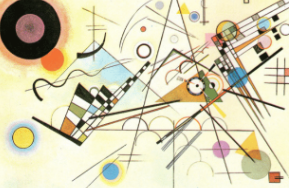Composition VIII
(1) Composition VIII was painted by Wassily Kandinsky in 1923. This oil painting was completed while Kandinsky taught at the Bauhaus, which was known as a controversial school of art and design. This work of him illustrates how Kandinsky was inspired by abstract art. Instead of using people, the painting includes geometrical shapes li ke triangles, circles, and the checkerboard. In Composition 8, the colorful, interactive geometric forms create a surface that is dynamic and calm, aggressive and quiet. The circles in this painting play an important role , too.
(2) Kandinsky is often known as the founder of abstract art, a form that uses shapes and symbols instead of real people. Composition 8 is one of his first paintings that displays this form of art. And as its title suggests it is influenced by music. He compose d colours and shapes to create what he was feeling. Kandinsky believed that , like music , colors trigger emotions. Red was lively and confident; Green was peaceful with inner strength; Blue was deep and supernatural; Yellow could be warm, exciting, disturbing or totally bonkers; and White seemed silent but full of possibilities. He also assigned instrument to nes to go with each color: Red sounded like a trumpet; Green sounded like a middle - position violin; Light Blue sounded like the flute; Dark Blue sounded like a cello, Yellow sounded like a fanfare of trumpets; and White sounded like the pause in a harmonio us melody. These comparisons to sounds came from Kandinsky's appreciation for music, especially that by the contemporary Viennese composer Arnold Schoenberg (1874 - 1951). Kandinsky's titles often refer to the colors in the composition or to music, for examp le "composition."
(3) Composition 8 is exhibited in the Solomon R. Guggenheim Foundation in New York. Every year it is seen by millions of art lovers.

